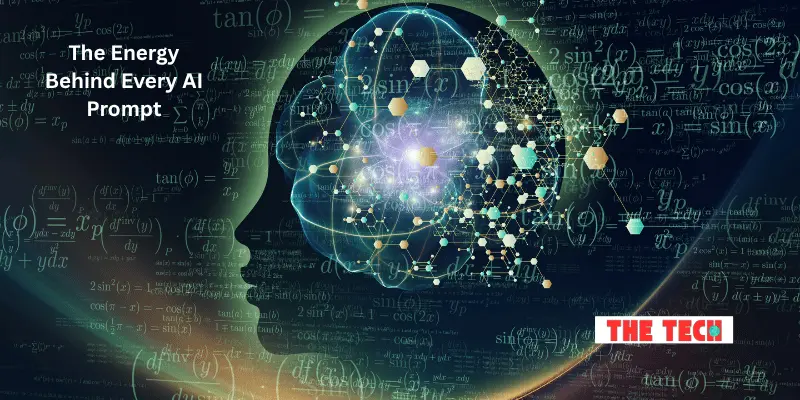How Much Energy Does AI Use? The Hidden Costs of Intelligence
Published: June 19, 2025
How Much Energy Does AI Use? These days, artificial intelligence (AI), is becoming an increasingly significant part of our daily lives.
We use it to write messages, talk to chatbots, create pictures, and even get answers to our questions. It saves us time and makes things easier.
However, most people are unaware that every time we use AI, it consumes a significant amount of electricity behind the scenes.
Powerful computers are working nonstop in the background to make AI run, and that takes energy.
While we often discuss the benefits of AI, we frequently overlook its energy consumption and environmental impact.
As AI becomes more common in our homes, schools, and offices, it’s essential to also think about the hidden cost of all this innovative technology.
The Energy Behind Every Prompt

Each time someone types a question into ChatGPT, asks a virtual assistant for help, or creates an AI-generated artwork, energy is being used.
Studies have found that a single interaction with a language model can consume up to three watt-hours of electricity.
This might sound small, but when multiplied by millions of users making countless requests each day, the total usage becomes enormous.
Many people believe that training large AI models is the main energy drain.
However, what often goes unnoticed is that using the models—known as inference—is now the most significant contributor to energy use.
Recent studies show that inference consumes more than sixty percent of AI’s total electricity usage.
This is important because as more businesses and individuals adopt AI tools, inference happens constantly in real-time and on a massive scale.
Data Centers – The Real Powerhouses
The heart of AI operations lies in vast data centers. These facilities, filled with servers and cooling systems, power everything from search engines to cloud storage—and now AI models too.
In the United States alone, data centers currently consume around 239 terawatt-hours of electricity every year.
This is almost as much as the entire state of Florida uses annually.
Globally, experts expect AI-powered data centers to use up to 945 terawatt-hours by 2030, putting them on par with the electricity needs of an entire country like Japan.
What often gets overlooked is the fact that many of these data centers are still powered by fossil fuels.
This means that every AI interaction contributes to carbon emissions and air pollution.
In some areas, data centers are the largest local consumers of electricity, putting pressure on regional grids and increasing the risk of blackouts and power shortages.
Water and AI – The Overlooked Link
One of the least discussed aspects of AI energy use is its impact on water resources. Data centers need constant cooling to prevent servers from overheating.
This is often achieved using water-based systems. When large AI models like GPT-4 are trained, they generate so much heat that hundreds of thousands of litres of fresh water are used to keep things running safely.
In regions where water is already scarce, this poses a significant environmental challenge.
In some U.S. states and parts of Asia, AI data centers are located in areas facing droughts and water stress.
The competition between AI operations and communities in need of clean water is becoming a growing concern that deserves more attention.
The Environmental Shadow of AI Chips
While electricity and cooling are commonly mentioned, the energy required to create the actual hardware used in AI models is often left out of the conversation.
Modern AI systems rely on powerful chips, like the H100 series developed by NVIDIA. Manufacturing these chips involves mining rare metals, refining materials, and using energy-intensive production methods.
This hardware also becomes outdated quickly. As newer, faster chips are developed, older ones are discarded, leading to large amounts of electronic waste.
By 2030, AI-related systems are expected to contribute between 1.2 and 5 million tonnes of e-waste globally.
These discarded parts often end up in landfills, releasing toxic materials and causing long-term environmental damage.
Training Costs – Still Massive
Although the focus is shifting toward the energy used during AI model training, the training process itself remains extremely demanding.
For example, training the GPT-3 model took about 1,287 megawatt-hours of electricity. That is more than the average annual energy use of 120 homes in the United States.
Even more advanced models, like GPT-4, are believed to have required much more energy, though exact figures are not publicly available.
What’s concerning is that most AI companies do not share these energy statistics.
A recent report showed that around 84 percent of developers fail to publish any details about the carbon emissions or electricity use of their AI models.
This lack of transparency makes it hard to fully understand the environmental cost of developing advanced artificial intelligence.
What’s Next? Tech Needs Transparency
As AI continues to evolve, companies and governments must take action to mitigate its energy impact.
Efforts are already underway to build more efficient chips, utilise renewable energy sources, and develop improved cooling systems.
Some firms are exploring liquid cooling technologies and modular data centers that reduce power waste. These steps are essential, but not enough on their own.
It is also essential for tech companies to be transparent about the energy consumption of their AI systems. Without this information, users and policymakers cannot make informed decisions.
Across the world, new regulations are being proposed to hold AI firms accountable for their environmental footprint.
The European Union’s AI Act and recent U.S. policy proposals are early signs that transparency is becoming a priority.
Final Thought – We Can’t Afford Blind AI
Artificial intelligence is changing the world in powerful ways. However, as we become increasingly dependent on these tools, we must also consider the hidden costs.
AI utilises real-world resources—such as electricity, water, and metals—and its impact extends far beyond a single device or screen.
The question “How much energy does AI use?” is more than a technical query. It is a reminder that intelligence, even artificial, comes with responsibility.
If we want a sustainable future, we must demand not just more intelligent AI, but greener and more accountable AI too.
What People Want to Know?
AI can consume a significant amount of electricity, particularly when large models, such as ChatGPT or image generators, are in operation. A single AI request can use 10 times more energy than a regular Google search. When millions of people use AI every day, the total energy adds up quickly.
Training big AI models like GPT-4 uses a lot of energy, sometimes equal to what dozens of homes use in a year. However, now that AI (called inference) is being used more frequently, it consumes even more energy overall, as people utilise it daily.
AI itself isn’t “bad,” but it does affect the environment. It uses electricity, often from fossil fuels, and needs water for cooling big computer centers. If this energy comes from non-renewable sources, it can contribute to increased pollution and exacerbate climate problems.
Yes. Many tech companies are working to improve AI by utilising cleaner energy, more efficient cooling systems, and smaller, more compact models. Some are even moving data centers to cooler places to save energy on cooling.
Because it happens behind the scenes. When we use AI tools, we only see the results, not the vast data centers and power that run them. Additionally, many companies don’t share complete details about their energy use, which makes it more difficult for people to understand the actual impact.

- Be Respectful
- Stay Relevant
- Stay Positive
- True Feedback
- Encourage Discussion
- Avoid Spamming
- No Fake News
- Don't Copy-Paste
- No Personal Attacks



- Be Respectful
- Stay Relevant
- Stay Positive
- True Feedback
- Encourage Discussion
- Avoid Spamming
- No Fake News
- Don't Copy-Paste
- No Personal Attacks





